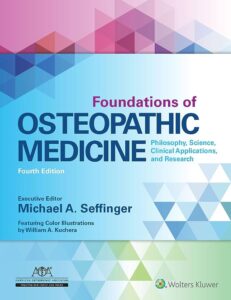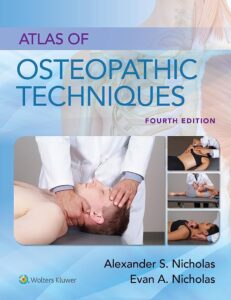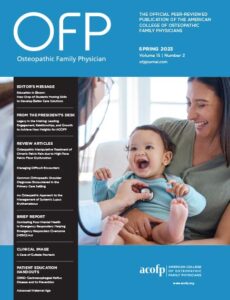Written Exam
In order to obtain the Osteopathic Manipulative Treatment (OMT) designation, you must hold an active primary AOA board certification from a qualifying AOA specialty certifying board. The Written Exam for the Osteopathic Manipulative Treatment (OMT) designation is offered once a year in the fall.
Eligibility
Osteopathic physicians must hold an active primary AOA board certification from one of the following AOA specialty certifying boards:
- American Osteopathic Board of Anesthesiology
- American Osteopathic Board of Dermatology
- American Osteopathic Board of Emergency Medicine
- American Osteopathic Board of Internal Medicine
- American Osteopathic Board of Neurology & Psychiatry
- American Osteopathic Board of Nuclear Medicine
- American Osteopathic Board of Obstetrics & Gynecology
- American Osteopathic Board of Ophthalmology & Otolaryngology
- American Osteopathic Board of Orthopedic Surgery
- American Osteopathic Board of Pathology
- American Osteopathic Board of Pediatrics
- American Osteopathic Board of Physical Medicine & Rehabilitation
- American Osteopathic Board of Preventive Medicine
- American Osteopathic Board of Proctology
- American Osteopathic Board of Radiology
- American Osteopathic Board of Surgery
Non-osteopathic physicians who hold an active primary AOA board certification are eligible to apply for the OMT designation if:
- They completed the osteopathic educational requirements in an ACGME accredited residency program with Osteopathic Recognition
OR
- Completed an ACGME accredited residency program without Osteopathic Recognition but have obtained BOS and specialty board approved training in OMM.
Requirements
To sit for the OMT designation written exam, submit a completed application, including the application fee.
Exam Fees
An exam fee of $250 is due at the time of application if submitted by the application deadline. Applications submitted late are subject to a late fee. An application is considered pending until all fees have been remitted.
Exam Cancellation Fees
- 0 – 30 days before the exam: no refund
- 31 days or more prior to the exam date: 50% refund
- Rejected Applications: 75% refund
- No refunds of late fees
Note: Please make certain that you are eligible and meet the requirements prior to submitting your application.
Exam Dates and Deadlines
The OMT designation written exam will be offered on Sept. 10-12, 2024, via remote proctoring platform. The application period will open on March 1, 2024.
Candidates that need special exam accommodations must submit their requests in writing at the time of application. All information must be received at least 30 days prior to the exam administration date.
Exam Content Outline
The Written Exam for the OMT designation consists of 70 multiple-choice, single-answer questions in a pass/fail format. All questions are evenly weighted, and the examination is subjected to conventional psychometric analysis using accepted modern methods of key validation and item scoring. The total examination time is two hours and will be proctored. No questions pertaining to exam content are allowed during the examination.
The Written Exam tests your knowledge and understanding of basic science and clinical knowledge, skills, and principles critical to OMT designation. The exam uses a single-best-answer multiple-choice format with 4-5 options per question. Questions are categorized as follows:
- Knowledge: Remembering facts, terms, methods, classifications, and principles.
- Comprehension: Understanding the meaning of the material, understanding how facts relate to one another, generalization of facts and interpretation of material.
- Application: Using information in concrete situations, analysis of components and relationships, development of a plan or solution, and making judgments about the value of material in specific situations.
| OMT Designation Table of Specification |
|---|
Osteopathic Foundations, Philosophy and Models |
| The overall exam is designed to assess focus on the person using combination of body, mind and spirit. The understanding of the inter-relationship of structure and function when examining and treating the person, by incorporating self-regulation, self-healing and health maintenance in patient care. |
I. Assessment and Diagnosis (42%) |
| Perform structural exam to determine deviations from normal Perform structural exam to determine abnormal functional relationship Integrate biomechanics into assessment and diagnosis Include interface of mental health and manual medicine Use OMT skills when diagnosing Osteopathic Structural Exam to Identify Somatic Dysfunction Perform structural exam to assess change in body structure and implications for disease and pain Identify how changing body structure (age/disease/pregnancy) can impact conditionRegional Anatomic Exam as Basis for Somatic Dysfunction Diagnosis Perform palpation to identify regional anatomic issues and somatic dysfunctionPostural Considerations in Somatic Dysfunction Observe patient posture during encounter and diagnose postural issues Assess visceral ad somatic reflexes Consider multi-systems interactions when developing a diagnosis |
II. Developing an Osteopathic Manipulative Treatment (39%) |
| Develop a plan to assist the body to heal itself Use a holistic approach to treatment and care Follow-up with referrals for complete and holistic care (family, consulting physician) Follow-up with consultations to ensure comprehensive care Perform OMT |
III. Osteopathic Treatment Planning (10%) |
| Application of OPP and OMM for special populations Consider those special populations that all specialties address. For example, but not limited to:
Develop OPP and OMM treatment plan |
IV. Professional Roles and Responsibilities (9%) |
| Consider legal and ethical issues when providing care Perform billing/coding to maximize treatment availability |
Suggested Reference List
Disclaimer: The Suggested Reference List shows the actual books from where the exam questions were written. This list is updated periodically throughout the year. This is not meant to be a required reading list, nor should it be considered all-inclusive, but it can assist you in your exam preparation.
 |
Foundations of Osteopathic Medicine, 4th edition |
 |
Atlas of Osteopathic Techniques, 4th edition |
 |
Journal of Osteopathic Medicine |
 |
Osteopathic Family Physician |
Exam Scoring
Scoring Criteria
AOA reports candidates’ certification results using standardized scaled scores. Scaled scores are more valid and reliable compared to raw scores and make scores comparable across different forms of the exam. The AOA reports scores on a 200 to 800-point scale with a scaled score of 500 or higher required to pass.
- A scaled score of 500 represents the minimum level of knowledge and skill necessary to pass the exam as established by AOA Certifying Boards.
- The highest possible scaled score is 800.
- The lowest possible scaled score is 200.
- Overall scores are based on the total number of items answered correctly, regardless of content area.
Results by content area
- When possible, a breakdown of exam scores by content area is provided to help you identify your areas of strength and areas that may need more development.
- The number of items for each content area indicates the relative amount of test questions on the exam for that content area.
- Content area scores are not weighted to calculate your overall score; each content area is scored separately after the overall analysis is complete.
Rescoring of Written Examinations
- Candidates have the right to request a rescore and audit process of their examination scores. Requests for the rescoring and audit must be submitted to the Committee in writing via formal letter emailed within one month of the Board’s release of the exam results. The fee for rescoring and audit is $200. The Board will commence the rescoring and audit process following receipt of the candidate’s request and payment. This process is limited to rescoring and audit of the candidate’s written exam only. Candidates are not allowed to review specific items on the examination. The Board will not reevaluate or reset the “cut” score for passing the exam.
Exam Failure
Candidates who do not pass the OMT designation written exam may apply for reexamination at the next administration.